Effectiveness of Grassland Protection and Pastoral Area Development under the Grassland Ecological Conservation Subsidy and Reward Policy
Abstract
:1. Introduction
2. Materials and Methods
3. Results and Discussion
3.1. Effectiveness of Ecological Protection
3.1.1. Steady Increase in Grassland Vegetation Coverage and Enhanced Production Support Capacity
3.1.2. Livestock Overloading Rate Continued to Decline, and Resource Utilization Became More Rational
3.1.3. Sustained Improvement of the Grassland Ecological Environment and Effective Control of Rodents and Pests
3.2. Effectiveness of Livestock Production
3.2.1. Promote the Implementation of Grassland Contracting and Enhance the Vitality of Pastoral Areas
3.2.2. Stable Decrease in Livestock in Pastoral Areas and Gradual Optimization of Livestock Quantity Pattern
3.2.3. Increase in Beef and Mutton Supplies and Steady Improvement in Herbivorous Livestock Product Yield
3.2.4. Diversification of Grassland Grazing Utilization and Optimal Transformation of Production Methods
3.3. Effectiveness of Social Development
3.3.1. GECSRP Ensures a Stable Income for Farmers and Herders
3.3.2. GECSRP Improves Labor Transfer and Effectively Mitigates Grassland Environmental Carrying Capacity
4. Discussion
4.1. Effectiveness of GECSRP
4.2. Major Issues
4.2.1. The Low Standard and Weak Mechanism of Subsidies and Awards Make It Difficult to Consolidate the Achieved Effect
4.2.2. Insufficient Supporting Measures and Funding Affect the Efficiency and Expected Outcomes of Policy Implementation
4.2.3. Insufficient Multi-Policy Integration of the National Subsidy Policy and Local Development
4.2.4. Herders’ Livelihoods Are Highly Dependent on Traditional Animal Husbandry, and It Is Difficult to Regulate and Control Grazing Overload Using Policy
4.2.5. Weak Construction of Grassland Law Enforcement and Supervision System, Supporting Technical Means to Strengthen Innovation
4.3. Policy Recommendations
4.3.1. Change from a Single Supplement to a Higher Standard and Policy Expansion
4.3.2. Change from Single Control of Livestock Volume to Dual Assessment of Livestock Volume and Ecology
4.3.3. Change from a Livestock Reduction Strategy to Promoting Industrial Development
4.3.4. Change from Transfer Payments to Attaching Importance to the Development of Farmers and Herdsmen
4.3.5. Change from a Supplemental Mechanism to Diversified Ecological Compensation
4.4. Application and Future Work
5. Conclusions
Supplementary Materials
Author Contributions
Funding
Institutional Review Board Statement
Informed Consent Statement
Data Availability Statement
Conflicts of Interest
References
- Bardgett, R.D.; Bullock, J.M.; Lavorel, S.; Manning, P.; Schaffner, U.; Ostle, N.; Chomel, M.; Durigan, G.; Fry, E.L.; Johnson, D.; et al. Combatting global grassland degradation. Nat. Rev. Earth Environ. 2021, 2, 720–735. [Google Scholar] [CrossRef]
- Lüscher, A.; Mueller-Harvey, I.; Soussana, J.F.; Rees, R.M.; Peyraud, J.L. Potential of legume-based grassland–livestock systems in Europe: A review. Grass Forage Sci. 2014, 69, 206–228. [Google Scholar] [CrossRef] [PubMed]
- Teka, A.M.; Woldu, G.T.; Fre, Z. Status and determinants of poverty and income inequality in pastoral and agro-pastoral communities: Household-based evidence from Afar Regional State, Ethiopia. World Dev. Perspect. 2019, 15, 100123. [Google Scholar] [CrossRef]
- David, K.; Han, G.; Hou, F.; Hou, X.; Li, Z.; Sun, Y.; Wang, Z.; Wu, J.; Zhang, X.; Zhang, Y.; et al. Sustainable management of Chinese grasslands—Issues and knowledge. Front Agric Sci. Eng. 2018, 5, 9–23. [Google Scholar] [CrossRef]
- Li, X.; Yin, X.; Zhou, X.; Li, P. Background and achievements of China’s subsidy and award policy for farmers and herdsmen. Acta Pratac. Sin. 2020, 29, 163–173. [Google Scholar] [CrossRef]
- Liu, M.; Dries, L.; Huang, J.; Min, S.; Tang, J. The impacts of the eco-environmental policy on grassland degradation and livestock production in Inner Mongolia, China: An empirical analysis based on the simultaneous equation model. Land Use Policy 2019, 88, 104167. [Google Scholar] [CrossRef]
- Yang, C.; Wang, M.; Meng, Z.; Yang, X. A Study of the Effects of the Grassland Ecological Protection Subsidiary-Award Policy on China’s Grassland Ecology. In Proceedings of the 2015 4th International Conference on Sustainable Energy & Environmental Engineering, Shenzhen, China, 20–21 December 2015. [Google Scholar] [CrossRef] [Green Version]
- Lin, H.; Zhao, Y.; Kalhoro, G.M. Ecological response of the subsidy and incentive system for grassland conservation in China. Land 2022, 11, 358. [Google Scholar] [CrossRef]
- Hu, Y.; Huang, J.; Hou, L. Impacts of the grassland ecological compensation policy on household livestock production in China: An empirical study in Inner Mongolia. Ecol. Econ. 2019, 161, 248–256. [Google Scholar] [CrossRef]
- Wang, Y.; Han, Y.; Han, Y.; Li, W. Does the grassland ecological compensation policy improve the herders’ breeding technical efficiency in China? —Based on the parallel mediation effect model. PLoS ONE 2021, 16, 0249990. [Google Scholar] [CrossRef]
- Byrne, A.T.; Hadrich, J.C.; Robinson, B.E.; Han, G. A factor-income approach to estimating grassland protection subsidy payments to livestock herders in Inner Mongolia, China. Land Use Policy 2020, 91, 104352. [Google Scholar] [CrossRef]
- Dong, X.; Dai, G.; Ulgiati, S.; Na, R.; Zhang, Y.; Kang, M.; Wang, X. On the relationship between economic development, environmental integrity and well-being: The point of view of herdsmen in northern China grassland. PLoS ONE 2015, 10, 0134786, eCollection 2015. [Google Scholar] [CrossRef]
- Zhang, J.; Brown, C.; Qiao, G.; Zhang, B. Effect of eco-compensation schemes on household income structures and herder satisfaction: Lessons from the grassland ecosystem subsidy and award scheme in Inner Mongolia. Ecol. Econ. 2019, 159, 46–53. [Google Scholar] [CrossRef]
- Ding, W.; Hou, X.; Yin, Y.; Li, X.; Wang, D. Are herdsmen overloaded? Who is overloading and its influencing factors under the grassland supplementary award policy—A case of Inner Mongolia? Acta Agrestia Sin. 2020, 28, 12–19. [Google Scholar] [CrossRef]
- Feng, X. Adaptative Study on the Herdsmen’ Production Decision Making Behavior to Grassland Eco-Protection Subsidy and Incentive Policy. Ph.D. Thesis, Chinese Academy of Agricultural Sciences, Beijing, 2019. [Google Scholar]
- Wang, J.; Wang, Z.; Xu, L.; Ding, Y. Problems and countermeasures in the implementation of grassland ecologic grant-premium mechanism based on investigation of household in Xilinhot. Chin. J. Grassl. 2016, 38, 1–7+12. [Google Scholar] [CrossRef]
- Hou, L.; Fang, X.; Chen, Q.; Huang, J.; He, Y.; Rose, N.; Rozelle, S. Grassland ecological compensation policy in China improves grassland quality and increases herders’ income. Nat. Commun. 2021, 12, 4683. [Google Scholar] [CrossRef] [PubMed]
- Li, Z.; Rao, D.; Liu, M. The impact of China’s grassland ecological compensation policy on the income gap between herder households? A case study from a typical pilot area. Land 2021, 10, 1405. [Google Scholar] [CrossRef]
- Yin, Y.; Hou, Y.; Langford, C.; Bai, H.; Hou, X. Herder stocking rate and household income under the Grassland Ecological Protection Award Policy in northern China. Land Use Policy 2019, 82, 120–129. [Google Scholar] [CrossRef]
- Hu, Z.; Kong, D.; Jin, L. Grassland eco-compensation: Rate differentiations of “Reward for Balanced Grazing” and its reasons. China Popul. Resour. Environ. 2015, 25, 152–159. [Google Scholar] [CrossRef]
- Guan, S.; Fan, Y.; Tang, Z. Herders’ willingness-to-participate in the Grassland Ecological Compensation and Award Policy in China: A meta-analysis. Rangel. J. 2021, 43, 267–280. [Google Scholar] [CrossRef]
- Hu, Z.; Liu, D.; Kong, D.; Jin, L. Rate calculation of “subsidies for grazing prohibition” in grassland eco—Compensation based on opportunity cost method. J. Arid Land Resour. Environ. 2017, 31, 63–68. [Google Scholar] [CrossRef]
- Wang, J.; Yan, M.; Qiao, J.; Zhao, H.; Li, P. The efficiency of grassland eco-compensation policy application and future suggestion. Chin. J. Grassl. 2020, 42, 8–14. [Google Scholar] [CrossRef]
- Jimoh, S.O.; Feng, X.; Li, P.; Hou, Y.; Hou, X. Risk-overgrazing relationship model: An empirical analysis of grassland farms in northern China. Rangel. Ecol. Manag. 2020, 73, 463–472. [Google Scholar] [CrossRef]
- Dong, L.; Feng, L.; Luo, X.; Yang, F.; Yang, G.; Ma, H. Evaluation on the Implementation Effect of Grassland Premium Policy—based on the Empirical Research of Farmers in Ningxia Pastoral Areas. Ecol. Econ. 2019, 35, 212–215. [Google Scholar]
- National Forestry and Grassland Administration. China Grassland Monitoring Report; National Forestry and Grassland Administration: Beijing, China, 2006–2020. [Google Scholar]
- Editorial Committee of China Animal Husbandry and Veterinary Yearbook. China Animal Husbandry and Veterinary Yearbook; Agriculture Press: Beijing, China, 2006–2020. [Google Scholar]
- National Animal Husbandry Station. China Grassland Statistics; China Agriculture Press: Beijing, China, 2006–2020. [Google Scholar]
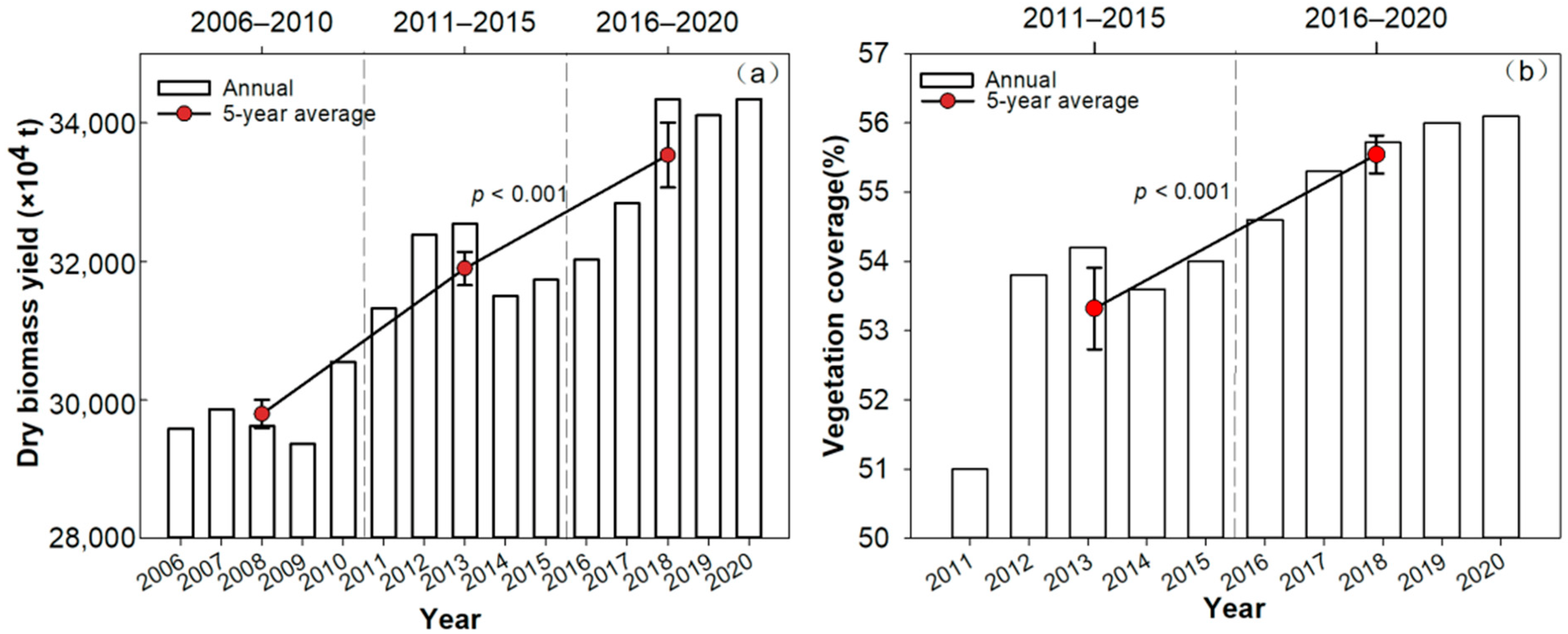
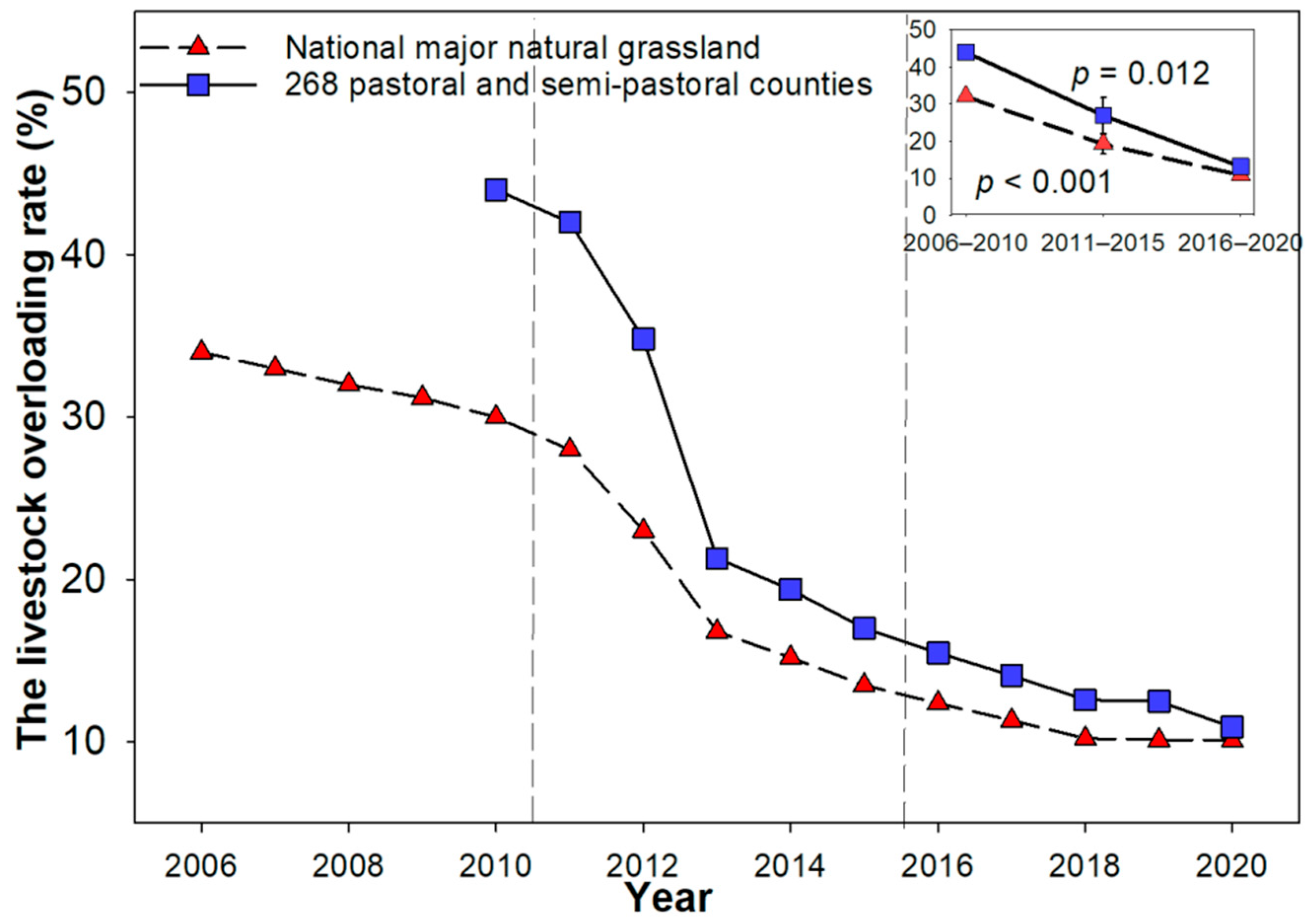
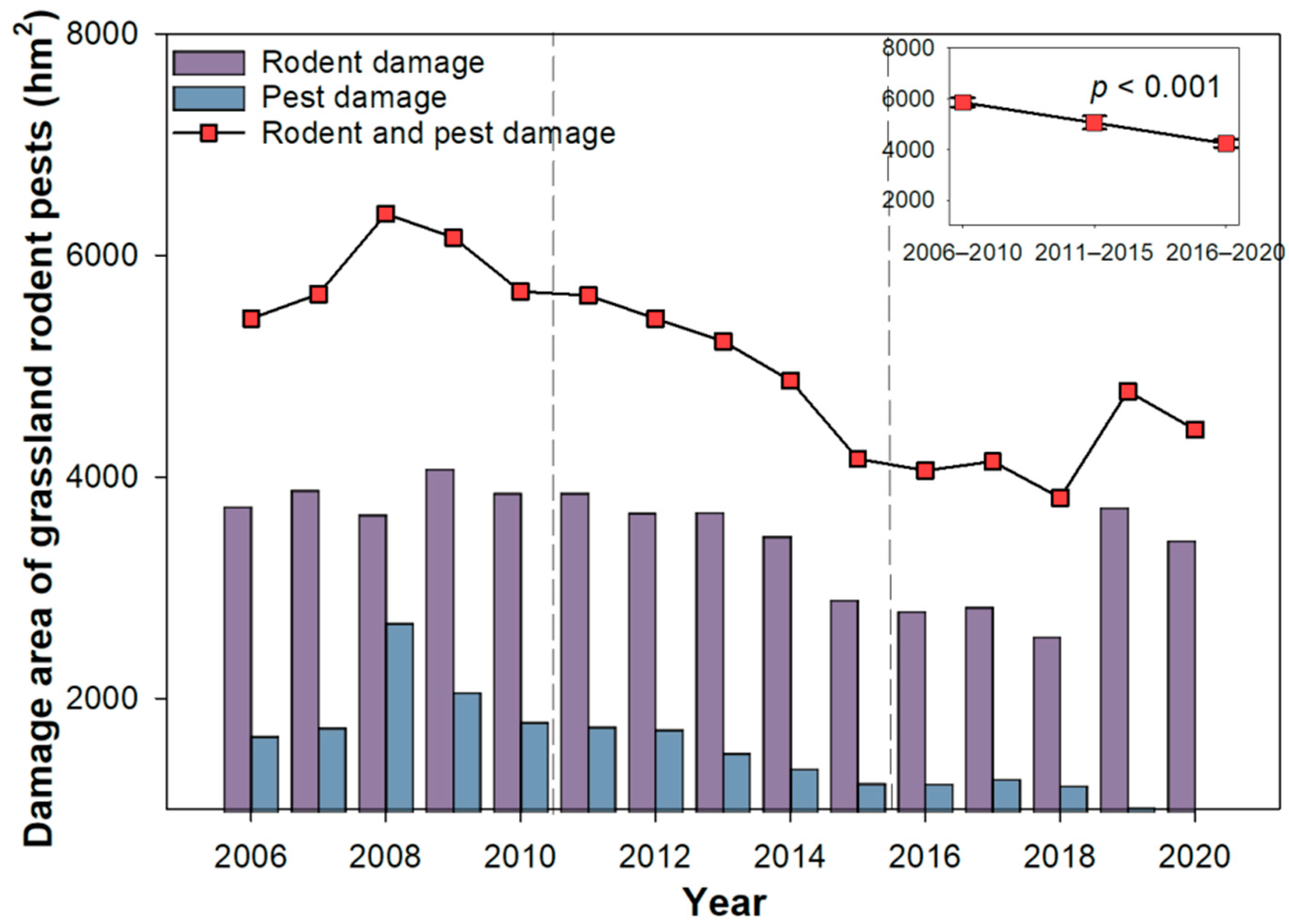
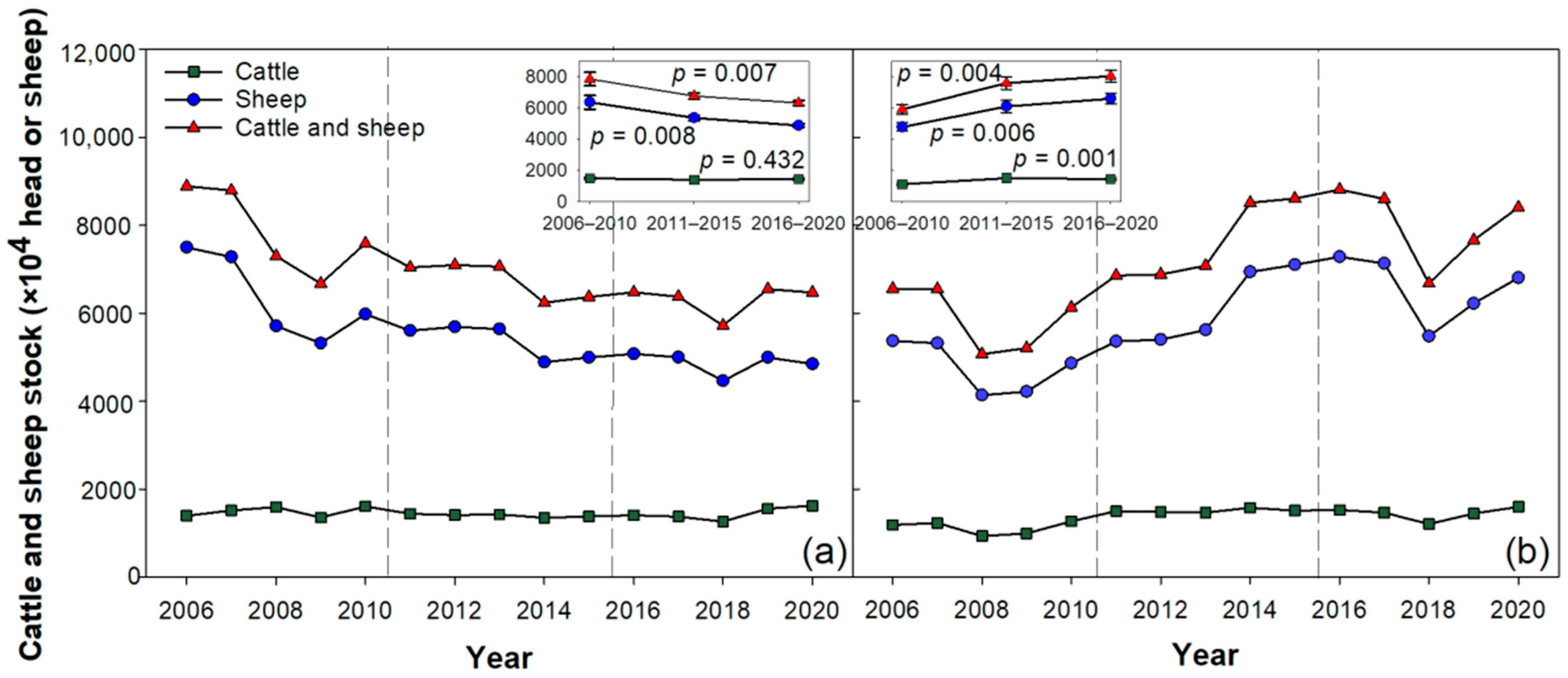
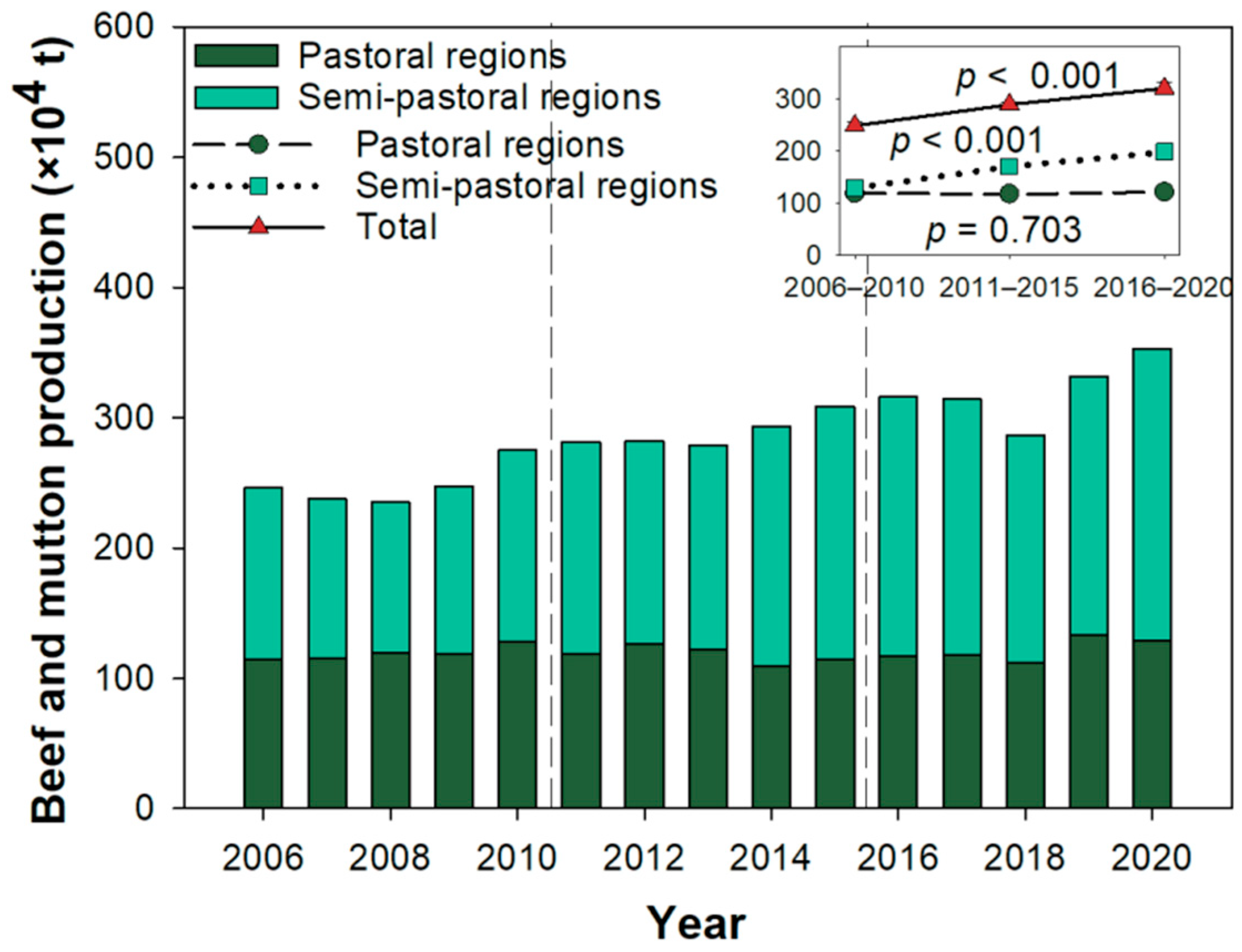
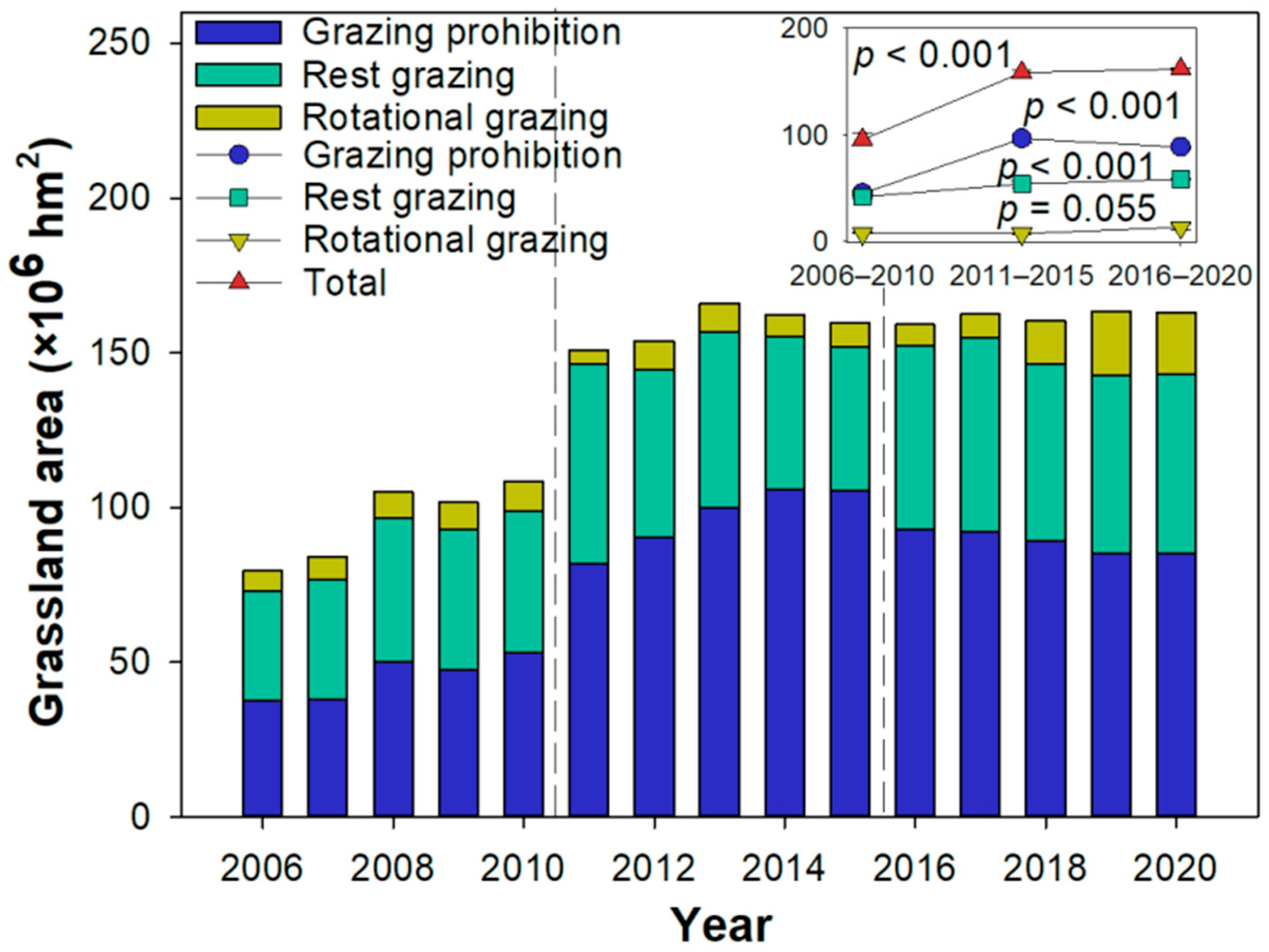
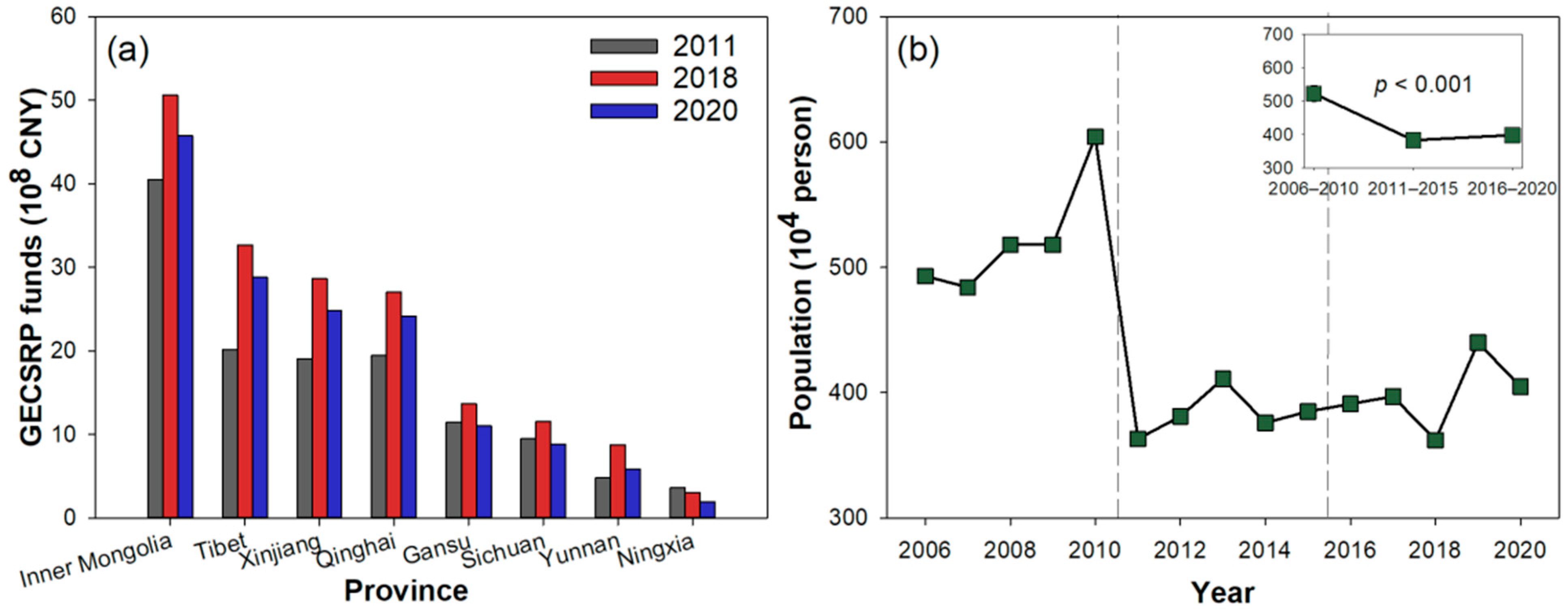
| Year | Cumulative Contracted Area (×106 hm2) | Contracted to the Household Area (×106 hm2) | Grassland Area (×106 hm2) | ||||
|---|---|---|---|---|---|---|---|
| Pastoral and Semi-Pastoral Regions | Pastoral Region | Semi-Pastoral Region | Pastoral and Semi-Pastoral Regions | Pastoral Region | Semi-Pastoral Region | ||
| 2010 | 181.62 | 135.75 | 45.87 | 140.90 | 110.35 | 30.55 | 233.98 |
| 2011 | 207.19 | 153.54 | 53.66 | 173.08 | 132.89 | 40.20 | |
| 2012 | 214.68 | 157.46 | 57.23 | 176.54 | 136.62 | 39.92 | |
| 2013 | 216.12 | 158.68 | 57.44 | 176.77 | 136.27 | 40.49 | |
| 2014 | 225.67 | 167.38 | 58.29 | 185.65 | 145.82 | 39.83 | |
| 2015 | 226.82 | 167.91 | 58.90 | 184.03 | 144.09 | 39.95 | |
| 2016 | 176.71 | 125.96 | 50.75 | 127.93 | 102.91 | 25.02 | |
| 2017 | 166.39 | 127.19 | 39.20 | 125.09 | 102.34 | 22.75 | |
| 2018 | 217.97 | 161.18 | 56.79 | 177.60 | 137.27 | 40.34 | |
| 2019 | 211.58 | 154.62 | 56.95 | 178.99 | 137.16 | 41.83 | |
| 2020 | 210.36 | 155.24 | 55.12 | 181.90 | 141.38 | 40.52 | |
| Province | Forbidden Grazing Subsidy (×104 CNY) | Grass–Livestock Balance Award (×104 CNY) | Subsidy for Planting Forages (×104 CNY) | Comprehensive Subsidy for Production Materials (×104 CNY) | Total Funds (×104 CNY) | Number of Herders (×104 Household) | Funds Received Per Household (CNY) |
|---|---|---|---|---|---|---|---|
| Yunnan | 16,386 | 22,604 | 7210 | 1715 | 47,915 | 3.43 | 13,969 |
| Tibet | 77,628 | 114,693 | 1060 | 7600 | 200,981 | 15.20 | 13,222 |
| Qinghai | 147,282 | 34,332 | 4500 | 8600 | 194,714 | 17.20 | 11,321 |
| Inner Mongolia | 242,940 | 92,265 | 45,220 | 24,050 | 404,475 | 48.10 | 8409 |
| Xinjiang | 90,000 | 81,135 | 5780 | 13,790 | 190,705 | 27.58 | 6915 |
| Gansu | 60,000 | 21,150 | 22,120 | 11,050 | 114,320 | 22.10 | 5173 |
| Sichuan | 42,000 | 21,300 | 8600 | 22,600 | 94,500 | 45.20 | 2091 |
| Ningxia | 21,336 | / | 5700 | 8874 | 35,910 | 17.75 | 2023 |
| Total | 697,572 | 387,479 | 100,190 | 98,279 | 1,283,520 | 196.56 | 6530 |
Publisher’s Note: MDPI stays neutral with regard to jurisdictional claims in published maps and institutional affiliations. |
© 2022 by the authors. Licensee MDPI, Basel, Switzerland. This article is an open access article distributed under the terms and conditions of the Creative Commons Attribution (CC BY) license (https://creativecommons.org/licenses/by/4.0/).
Share and Cite
Zhang, Y.; Wuriliga; Ding, Y.; Li, F.; Zhang, Y.; Su, M.; Li, S.; Liu, L. Effectiveness of Grassland Protection and Pastoral Area Development under the Grassland Ecological Conservation Subsidy and Reward Policy. Agriculture 2022, 12, 1177. https://doi.org/10.3390/agriculture12081177
Zhang Y, Wuriliga, Ding Y, Li F, Zhang Y, Su M, Li S, Liu L. Effectiveness of Grassland Protection and Pastoral Area Development under the Grassland Ecological Conservation Subsidy and Reward Policy. Agriculture. 2022; 12(8):1177. https://doi.org/10.3390/agriculture12081177
Chicago/Turabian StyleZhang, Yiran, Wuriliga, Yong Ding, Fang Li, Yujuan Zhang, Min Su, Shuhui Li, and Li Liu. 2022. "Effectiveness of Grassland Protection and Pastoral Area Development under the Grassland Ecological Conservation Subsidy and Reward Policy" Agriculture 12, no. 8: 1177. https://doi.org/10.3390/agriculture12081177
APA StyleZhang, Y., Wuriliga, Ding, Y., Li, F., Zhang, Y., Su, M., Li, S., & Liu, L. (2022). Effectiveness of Grassland Protection and Pastoral Area Development under the Grassland Ecological Conservation Subsidy and Reward Policy. Agriculture, 12(8), 1177. https://doi.org/10.3390/agriculture12081177






